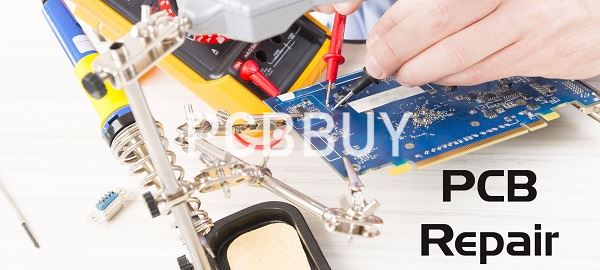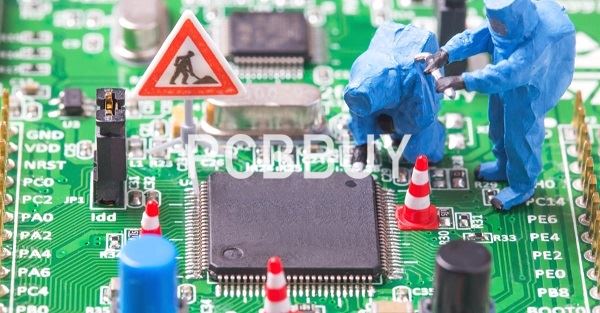PCB repair
By:PCBBUY 07/20/2021 09:12

A printed circuit board or PCB is a core component of nearly all electronic devices. Everything except the simplest of electronics uses a board of some kind to connect and mechanically sync all elements of the product. A coffee maker, for instance, might have a small PCB inside to connect the electronic control system, heater element and display.
In the early days—way before design software was a thing—printed circuit boards were planned using Mylar sheets through manual hands-on development, and were often four times bigger than the circuit board itself. The designers would lay pin pads, traces and components out in a proposed design, which was used sort-of like a storyboard to test and explain circuits. Today, it’s all done via design and manufacturing software.
It’s important to understand that circuit board repair parts and practices often consist of the same materials and components used to build the hardware in the first place. There are very few substitutes or alternatives, especially when talking about reliable and conductive materials. This highlights the need to find a proper, professional repair team with the right assets and connections.
If you want to order PCB product, please check and custom your order online.

What are the causes of PCB failures?
As with anything that deteriorates over time and extended use, printed circuit boards can run into a variety of problems. From trace damage which affects the conductivity of the board and circuit to component failure which sees capacitors or diodes dying, there are many points of contention on a circuit board.
It helps to identify and understand some of the most common failures, that way you can deal with the problem in a relevant manner. This may also help people—who don’t have direct experience with circuit boards—keep them in better shape.
1. Physical Damage
This is the more obvious choice when it pertains to the damage of a circuit board. In fact, the most common causes of PCB failures all stem from physical damage to a device or its internals. This can be just about anything pertaining to physical pressure or shock. The device in question might have been dropped from a great distance. Perhaps it was smacked or hit forcibly by another object? There’s also the possibility that the device was disassembled for whatever reason, and damage happened directly to the board.
How to Repair?
So long as complete failure is not the scenario—the board fell upon the ground and shattered or broke completely—physical damage can be remedied through the remanufacturing process. Generally, this involves melting down the damage sections of the board or repairing through disassembly and reassembly. Due to the nature of most physical damage, it’s highly unlikely that this can be done as a DIY project by those without experience with printed circuit board repair. The repair of physical damage should only be done by a trained and experienced professional. In most cases, it calls for remodeling of the board, resoldering of components, and the reballing of conductive traces.
2. Component Failure
Aside from physical damage, faulty components are the other most common cause of printed circuit board failures. In fact, if and when there is no physical damage but a device has failed to operate or power on, you can almost guarantee it has to do with one of the components connected to the board.
The component itself could be anything from a capacitor to a diode or microprocessor. If the component is the issue and has died or failed to work, it may need to be replaced entirely. However, it’s not always the actual component that’s the problem. Sometimes due to aging, overheating and voltage sags the trace circuit may have deteriorated to a point where it’s no longer conductive. It’s also possible that a component—or several—have dislodged entirely from the board and need to be reseated.
How to Repair?
You may be asking, how to fix a printed circuit board when a component fails? Again, the repair and manufacturing process for faulty components is best left to professionals. There are voltage tools and various devices that can be used to test the conductivity of a board’s circuit. They can also be used to discern if there’s electricity flowing to a component, or if an element of the board has failed entirely. A lot of times, by just opening up the device you can see components that have failed. Their outer shell may seem burnt, cracked or broken, or the component is completely detached from the board and loose.

To repair a faulty component, you may need to apply heat—usually with a heat gun—solder and conduct rigorous testing.
3. Trace Damage
Traces on a circuit board are the conductive pathways comprised of silver or copper. Generally, you can see an issue with traces using the naked eye, but not always. If a trace suffers damage, whether through regular use or physical damage then it can cause significant issues with the printed circuit boards conductivity, components and the device in question.
Some of the more common reasons for trace damage include lightning strikes, severe power surges or shorts, metallic dust contamination, overheating and normal wear.
How to Repair?
Provided the trace is not incredibly thin and difficult to see, you can usually discern damage simply by scanning the pathway. Copper and silver by nature are bright and shiny, which makes it easier to identify when there’s a break or damage. Keep in mind this is not always the case, but it’s a sure bet.
To repair faulty or damage trace pathways, you simply need to resolder or reball the board with the necessary material. This reconnects the broken circuit and allows electricity to flow freely throughout the board.
4. Poor Design
As much as we’d love to praise every single engineer or product developer in existence, that’s just not viable. Sometimes, for whatever reason, a team may cut corners when designing a board or manufacturing the necessary components. This can result in the poor design and construction of a board, which causes issues later down the line.
Unfortunately, poor design for a printed circuit board can lead to several things, many of the failures that happen are already discussed here.
How to Repair?
You’ll know as soon as you have a faulty or poor circuit board because your device will continue to fail time and time again, even after a repair or service session. The best solution for a shoddy circuit board is to replace it completely, by visiting an official or licensed repair center.
The easiest way to identify a poorly designed board is the number of failures or problems after extended use. Barring significant physical or electrical damage to the device, if you take the board to be repaired or analyzed somewhere and there are a handful of issues, there’s likely something wrong with the way the board was constructed. In some cases, this simply means the original manufacturer used cheap or unreliable components, but the board itself is fine.
Wanna know PCB knowledge? Check and read for more.
Industry Category











